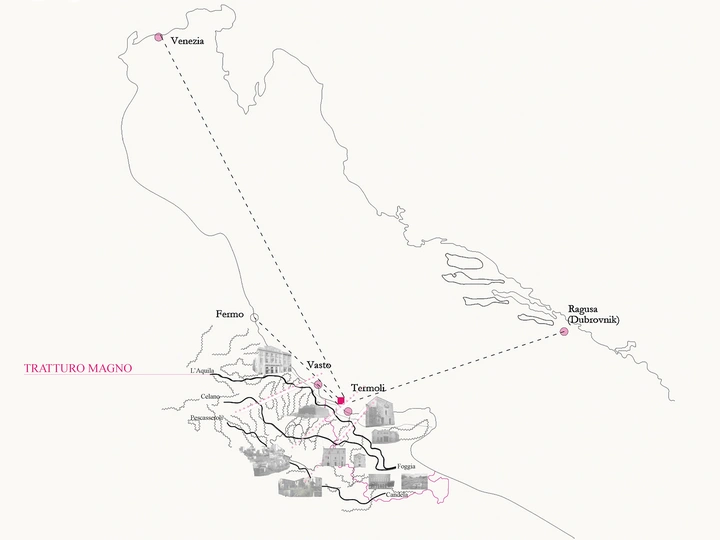Territorial garden along the “tratturi”

Lucia Concetta Vincelli
CALUMA is a collective founded by Carmine and Lucia Concetta Vincelli, which studies alternative narratives for architecture through audiovisual experimentations and performance, based on collaborations with multidisciplinary artistic figures. Through the audiovisual and performative lens, the group aims to investigate human activities and the places that relate to them.
CALUMA research is rooted in the first studies of the urban environment, with the video-documentary installation ‘La Strada’ at MAXXI (The Street. Where the World is made, curated by Hou Hanru, Rome 2018) analysing a street as a microcosm, a model of different ways of living. More recently, the group enlarged the focus on territorial studies: the projection of the video documentary ‘Sub Limen’ at the Venice Biennale 2021 opened an inquiry into the loss of the coastal landscape in Italy.
Founded in Molise, in central Italy, by twins Vincelli, the collective expands between Rome and Europe, convinced that architecture needs to amplify its narration.
Lucia Concetta Vincelli is an architect and a PhD candidate in Landscape and Environment at La Sapienza, University of Rome. In her research, she’s studying new domestic landscapes in temporary ways of living, focusing on the processes activated by the demolitions of contemporary housing in England and Italy. In 2022, she graduated in Architecture with a Master’s Degree thesis in Restoration with a proposal for an abandoned cinema in Termoli, along the “tratturi” infrastructure of Central Italy.
Carmine Vincelli (born in Molise in 1997) is a freelance architect and photographer. He employs street photography as a means of social and territorial analysis, a method that took him recently to Sicily for the "Bosco Colto" workshop, a project focused on the restoration of Europe's largest and oldest cork oak forest.
The fragmented trails of the “tratturi” in Central Italy, linking Abruzzo and Puglia, serve as vestiges of the legendary era of transhumance, where nomadic pastoralism roamed between mountains and valleys. These pathways, intertwined with architectural and economic legacies, now stand as remnants of a mythical past. Through its contemporary storytelling, the project seeks to highlight the present importance of this infrastructure and investigate ways to repurpose its architecture to benefit a rejuvenated local economy, beyond its UNESCO heritage or tourism status.
As today the sheep tracks vanish under asphalt and one-way roads, the environmental balance of the regions is threatened. From this ecological trauma and the seasonal dwelling history, the project encourages envisioning a territorial garden, a holistic model for land regeneration, in harmony with cyclical production processes.
Narration
Utilizing various experiences-walking, cycling, videomaking, and videomapping-the project begins by reconstructing the narrative of “tratturi” as a contemporary myth. It envisions the territory as interconnected gardens, transcending political borders, with modern migration as the central theme. It fosters awareness of land's ecology and social dynamics, linking urban-rural, industrial-agricultural sectors.
Laboratory
In its second phase, the project endeavours to establish workshops along the infrastructure, blending international and local insights. By repurposing “tratturi”’s proto-industrial heritage through design interventions, it aims to create a territorial laboratory and revive abandoned entertainment venues of the area into hubs for advanced agro-tertiary activities, using the network potential to link internal areas (with Tratturo Magno linking Aquila to Foggia) and Adriatic Sea routes.
Grounded in the concept of transhumance-“through the earth”-rethinking “tratturi” raises the question: is our movement containing architecture?